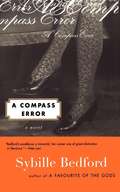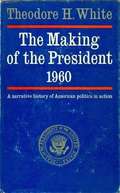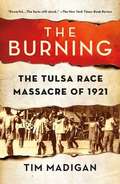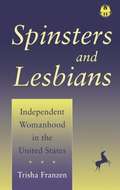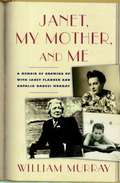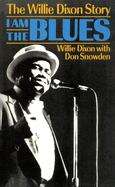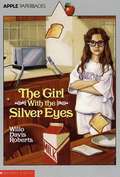- Table View
- List View
The Pencil Families
by Susan TerrisAfter she discovers a dead body floating in the lagoon, ten-year-old Emily's life becomes even more exciting than the fantasies she creates for her "pencil families."
A Compass Error
by Sybille BedfordFirst published in 1968. In this sequel to The Favourite of the Gods, seventeen-year-old Flavia, on her own in the south of France in the late 1930s, lives with the confidence and ardor of youth. She knows her destiny-it lies at Oxford, where she will begin a great career of public service. But this view of herself is at odds with reality; it springs from ideas she has of her idolized English father and of her blessed Italian mother, Constanza. Only when she is caught up in an intrigue that is to determine the fate of those she most loves does she begins to discover her own true nature-even as she loses the bearings of her moral compass.
Surplus: A Novel
by Sylvia StevensonFirst published in 1924. Relationship between two military women after the first world war.
American Speeches: Political Oratory from Abraham Lincoln to Bill Clinton
by Ted WidmerFrom the book: Public speeches have profoundly shaped American history and culture, transforming not only our politics but also our language and our sense of national identity. This volume collects the unabridged texts of 83 eloquent and dramatic speeches delivered by 45 American public figures between 1865 and 1997, beginning with Abraham Lincoln's last speech on Reconstruction and ending with Bill Clinton's heartfelt tribute to the Little Rock Nine. During this period American political oratory continued to evolve, as a more conversational style, influenced by the intimacy of radio and television, emerged alongside traditional forms of rhetoric. Included are speeches on Reconstruction by Thaddeus Stevens and African-American congressman Robert Brown Elliott, Frederick Douglass's brilliant oration on Abraham Lincoln, and Oliver Wendell Holmes's "touched with fire" Memorial Day Address. Speeches by Robert Ingersoll and William Jennings Bryan capture the fervor of 19th-century political conventions, while Theodore Roosevelt and Carl Schurz offer opposing views on imperialism. Ida B. Wells and Mary Church Terrell denounce the cruelty of lynching and the injustice of Jim Crow; Susan B. Anthony, Elizabeth Cady Stanton, and Carrie Chapman Catt advocate the enfranchisement of women; and Woodrow Wilson and Henry Cabot Lodge present conflicting visions of the League of Nations. Also included are wartime speeches by George Patton and Dwight Eisenhower; an address on the atomic bomb by J. Robert Oppenheimer; Richard Nixon's "Checkers Speech"; Malcolm X's "The Ballot or the Bullet"; Barry Goldwater's speech to the 1964 Republican convention; Mario Savio urging Berkeley students to stop "the machine"; Barbara Jordan defending the Constitution during Watergate; and an extensive selection of speeches by Franklin Roosevelt, Martin Luther King, John F. Kennedy, and Ronald Reagan. Ted Widmer, editor, is t
America in Search of Itself (Making of the President Ser. #5): The Making of the President 1956-1980
by Theodore H. WhiteAll of us have lived through a time of collision in America: of upheavals shattering old ideas and dreams-- transforming American politics in the process. In this, the last of his prize-winning series on American presidential politics, Theodore H. White tells us of the dramas that lie behind that transformation. He sets the stage by describing the forces that have changed American politics in the twenty-five years of his reporting. He tells how American goodwill created something called the Great Society... and pushed it over the cliff. He reveals how television took over American politics--and changed its nature; and he tells the terrifying story of the Great Inflation--and how it came to undermine all American life. And he details the equally disturbing story of how Americans have been ripped apart, divided and set against each other by the hopes that inspired men of goodwill to try to bring Americans together.
The Making of the President, 1960
by Theodore H. WhiteThe greatest political story ever told—the epic clash between John F. Kennedy and Richard M. Nixon, as captured in Theodore White's dramatic and groundbreaking chronicle<P><P> The Making of the President 1960 is the book that revolutionized—even created—modern political journalism. Granted intimate access to all parties involved, Theodore White crafted an almost mythic story of the battle that pitted Senator John F. Kennedy against Vice-President Richard M. Nixon—from the decisive primary battles to the history-making televised debates, the first of their kind. Magnificently detailed and exquisitely paced, The Making of the President 1960 imbues the nation's presidential election process with both grittiness and grandeur, and established a benchmark against which all new campaign reporters would measure their work. <P><P> Pulitzer Prize Winner
The Burning: MASSACRE, DESTRUCTION, aND tHE TULSA RACE RIOT oF 1921
by Tim MadiganON THE MORNING OF JUNE 1, 1921, A WHITE MOB NUMBERING in the thousands marched across the railroad tracks dividing black from white in Tulsa, Oklahoma, and obliterated a black community then celebrated as one of America’s most prosperous. Thirty-four square blocks of Tulsa’s Greenwood community, known then as the Negro Wall Street of America, were reduced to smoldering rubble. With chilling details, humanity, and the narrative thrust of compelling fiction, The Burning re-creates the town of Greenwood at the height of its prosperity, explores the currents of hatred, racism, and mistrust between its black residents and Tulsa’s neighboring white population, narrates events leading up to and including Greenwood’s annihilation, and documents the subsequent silence that surrounded the tragedy that became known as the Tulsa Race Riot.
Spinsters and Lesbians: Independent Womanhood in the United States
by Trisha FranzenAmericans have long held fast to a rigid definition of womanhood, revolving around husband, home, and children. Women who rebelled against this definition and carved out independent lives for themselves have often been rendered invisible in U.S. history. In this unusual comparative study, Trisha Franzen brings to light the remarkable lives of two generations of autonomous women: Progressive Era spinsters and mid-twentieth century lesbians. While both groups of women followed similar paths to independence--separating from their families, pursuing education, finding work, and creating woman-centered communities--they faced different material and cultural challenges and came to claim very different identities. Many of the turn-of-the-century women were prominent during their time, from internationally recognized classicist Edith Hamilton through two early Directors of the Women's Bureau, Mary Anderson and Freida Miller. Maturing during the time of a broad and powerful women's movement, they were among that era's new women, the often-single women who were viewed as in the vanguard of women's struggle for equality. In contrast, never-married women after World War II, especially lesbians, were considered beyond the pale of real womanhood. Before the women's and gay/lesbian liberation movements, they had no positive contemporary images of alternative lives for women. Highlighting the similarities and differences between women-oriented women confronting changing gender and sexuality systems, Spinsters and Lesbians thus traces a continuum among women who constructed lives outside institutionalized heterosexuality.
Transgender Journeys
by Virginia Ramey Mollenkott Vanessa SheridanTransgendered people and religious life.
Second-Wave Millennials: Tapping the Potential of America's Youth
by Warren WrightAuthor Warren Wright takes you on an engaging journey through the generations in the workplace, starting with “Dave” the Boomer, and ending with the newest kid on the block—“Samanthe”, a Second-Wave Millennial. Page-turning narrative peppered with practical solutions tells the compelling story of how different generations can get along in the workplace—with an emphasis on tapping the potential of the newest generation—Second-Wave Millennials. Second-Wave Millennials reveals: 5 ways to craft an ideal workplace for all generations 4 lifestyle themes that make up Millennials’ identity The top soft skills required for the newly-hired Second-WaveMillennials
Behind The Screen: How Gays and Lesbians Shaped Hollywood 1910-1969
by William J. MannWhether in or out of the closet, gays and lesbians played an essential role in shaping studio-era Hollywood. Gay actors (J. Warren Kerrigan, Marlene Dietrich, Rock Hudson), gay directors (George Cukor, James Whale, Dorothy Arzner), and gay set and costume designers (Adrian, Travis Banton, George James Hopkins) have been among the most influential individuals in Hollywood history and literally created the Hollywood mystique. This landmark study-based on seven years of exacting research and including unpublished memoirs, personal correspondence, oral histories, and scrapbooks-explores the experience of Hollywood's gays in the context of their times. Ranging from Hollywood's working conditions to the rowdy character of Los Angeles's gay underground, William J. Mann brings long overdue attention to every aspect of this powerful creative force.
Janet, My Mother, and Me: A Memoir of Growing Up With Janet Flanner and Natalia Danesi Murray
by Williamson MurrayJanet, My Mother, and Me is a charming, captivating memoir about a boy growing up in a household of two extraordinary women. William Murray was devoted to his mother, Natalia Danesi Murray, and to his mother's longtime lover, writer Janet Flanner. Even as a teenager, he accepted their unconventional relationship. His portrait of the two most important people in his life is unforgettable. Janet Flanner was already celebrated as the author of a new style of personal journalism for her "Letter from Paris" in The New Yorker when she met the Italian-born Natalia Murray on Fire Island, New York, in 1940. Their encounter, writes William Murray, was a "coup de foudre, a thunderbolt that instantly sent them rushing into each other's arms and forever altered their lives, as well as mine." Murray was already growing up in two cultures on different continents, in New York and Rome, when his mother's life changed so dramatically. He quickly accepted Flanner and the unusual household in which he found himself. (Natalia's mother, Mammina Ester, also lived with them in New York.) His memories of the women and of his own boyhood and adolescence are touching and often hilarious. Janet, My Mother, and Me offers a look at the world in which gay professional women moved in the decades before such relationships became more open and accepted. Murray's mother was a publishing executive and a broadcaster, and Murray, who originally hoped to become an opera singer and trained for that profession, eventually moved into the professions of both his mother and Flanner, becoming a novelist and then for many years an editor and writer at The New Yorker. This is an exuberant, warm, and often poignant memoir with a memorable cast of characters. Beguiling and unusual, it will remain vivid in readers' minds for years to come.
I am the Blues: The Willie Dixon Story
by Willie DixonI Am The Blues captures Willie Dixon's inimitable voice and character as he tells his life story: the segregation of Vicksburg, Mississippi, where Dixon grew up, the prison farm from which he escaped and then hoboed his way north as a teenager, his equal-rights-based draft refusal in 1942, his work--as songwriter, bassist, producer, and arranger--with Muddy Waters, Howlin' Wolf, Little Walter, Bo Diddley, and Chuck Berry which shaped the definitive Chicago blues sound of Chess Records: and his legal battles to recapture the rites to his historic catalog of songs. Don Snowden has supplemented Dixon's reflections with interviews with other performers and Chess insiders. In the Appendixes, Snowden gives a comprehensive discography and a list of the major artists who have recorded Dixon's songs.
The Girl with the Silver Eyes
by Willo Davis RobertsKatie Welker is used to being alone. She would much rather read a book than deal with other people. Other people don't have silver eyes and other people can't make things happen just by thinking about them! Sometimes Katie even enjoys playing tricks on people, but trouble arises when someone doesn't find her funny.

